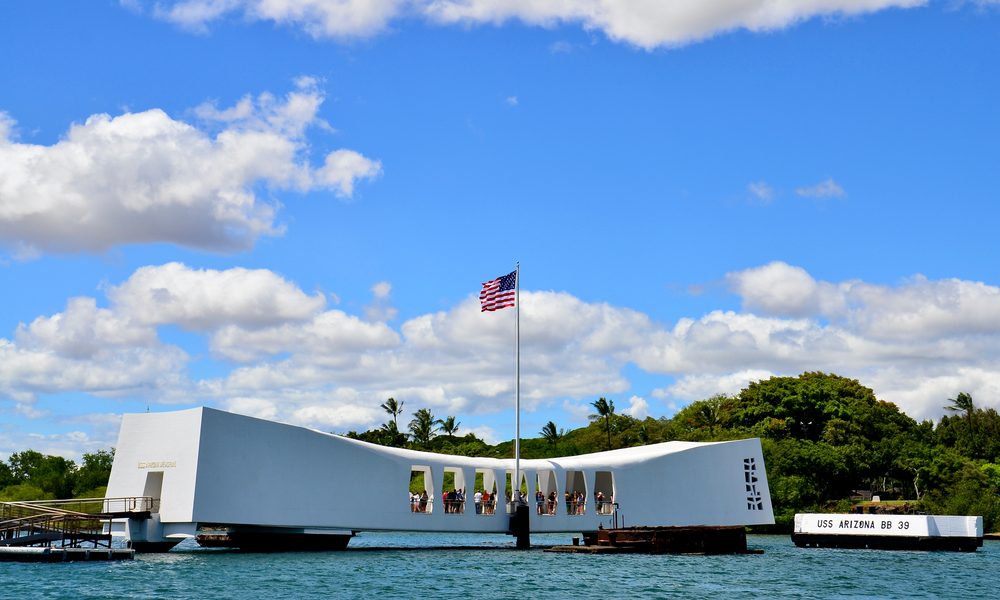The Pearl Harbor National Memorial, located on the island of Oahu in Hawaii, stands as a somber reminder of the tragic events of December 7, 1941, when the Imperial Japanese Navy Air Service launched a surprise military strike against the United States naval base at Pearl Harbor. This attack led to the United States’ formal entry into World War II. The memorial honors the 2,403 service members and civilians who lost their lives that day and serves as a place of reflection and education for visitors from around the world.
Historical Context of the Attack
On the morning of December 7, 1941, Pearl Harbor, home to the U.S. Pacific Fleet, was attacked without warning. The assault involved hundreds of Japanese fighter planes and resulted in the sinking of four U.S. Navy battleships, damaging four more, and the destruction of numerous aircraft. This act of aggression shocked the nation and catalyzed its entry into World War II.
USS Arizona Memorial
The centerpiece of the Pearl Harbor National Memorial is the USS Arizona Memorial, which straddles the sunken hull of the battleship USS Arizona. This battleship suffered catastrophic damage during the attack, and most of its crew were entombed within the vessel. The memorial, accessible only by boat, features a shrine room with the names of those killed on the USS Arizona engraved into a marble wall.
Design and Symbolism
The design of the USS Arizona Memorial is rich in symbolism. Its sagging center represents the initial defeat of the attack and the rise to victory at the ends symbolizes the ultimate victory of the United States in World War II. The structure’s white color stands for purity and sacrifice.
Visiting the Memorial
The experience of visiting the Pearl Harbor National Memorial is a powerful one, starting at the Pearl Harbor Visitor Center. Here, visitors can explore indoor and outdoor exhibits that provide historical context and recount personal stories from the attack. The visitor center also serves as the departure point for the Navy-operated shuttle boats to the USS Arizona Memorial.
Educational Exhibits
The visitor center houses two museums: the “Road to War” and the “Attack” exhibits. These museums offer detailed accounts of the events leading up to the war and the attack itself, including personal narratives, wartime artifacts, and interactive displays.
Remembrance Circle
The Remembrance Circle pays tribute to all those who made the ultimate sacrifice during the attack on Pearl Harbor. It is an area for reflection on the consequences of war and the importance of peace.
Additional Memorials
Beyond the USS Arizona Memorial, the Pearl Harbor National Memorial includes other significant sites:
- USS Oklahoma Memorial: This memorial honors the 429 crew members who lost their lives when the USS Oklahoma capsized during the attack.
- USS Utah Memorial: Located on the opposite side of Ford Island, this memorial commemorates the 58 men who died aboard the USS Utah.
- USS Missouri (BB-63): Moored near the USS Arizona Memorial, the “Mighty Mo” serves as a museum ship and is notable as the site where Japan formally surrendered, ending World War II.
Reflection and Legacy
The Pearl Harbor National Memorial is more than just a collection of monuments; it is a place for reflection on the past and its continued relevance. The site educates visitors about the impact of the Pearl Harbor attack on both the Pacific region and the world at large. It emphasizes not only the tragic loss of life but also the resilience and unity that followed in the wake of the attack.
Preservation and Commemoration
Maintained by the National Park Service, the memorial ensures that the stories and sacrifices of the victims are not forgotten. It hosts annual commemoration ceremonies on December 7th, attended by survivors, veterans, dignitaries, and the public.
The Visitor Experience
A visit to the Pearl Harbor National Memorial is often an emotional journey. Many leave with a deeper understanding of the events of December 7, 1941, and a renewed appreciation for the price of freedom. The serene setting allows for personal reflection on the sacrifices made during one of the most pivotal moments in U.S. history.
Conclusion
The Pearl Harbor National Memorial stands as an enduring testament to the individuals who lost their lives in the attack on Pearl Harbor. It is a place of education, a historical landmark, and a sacred site that commemorates the resilience of the human spirit in the face of tragedy. Through its preservation of history, the memorial continues to remind current and future generations of the importance of remembrance and the need for vigilance in protecting peace and liberty.







